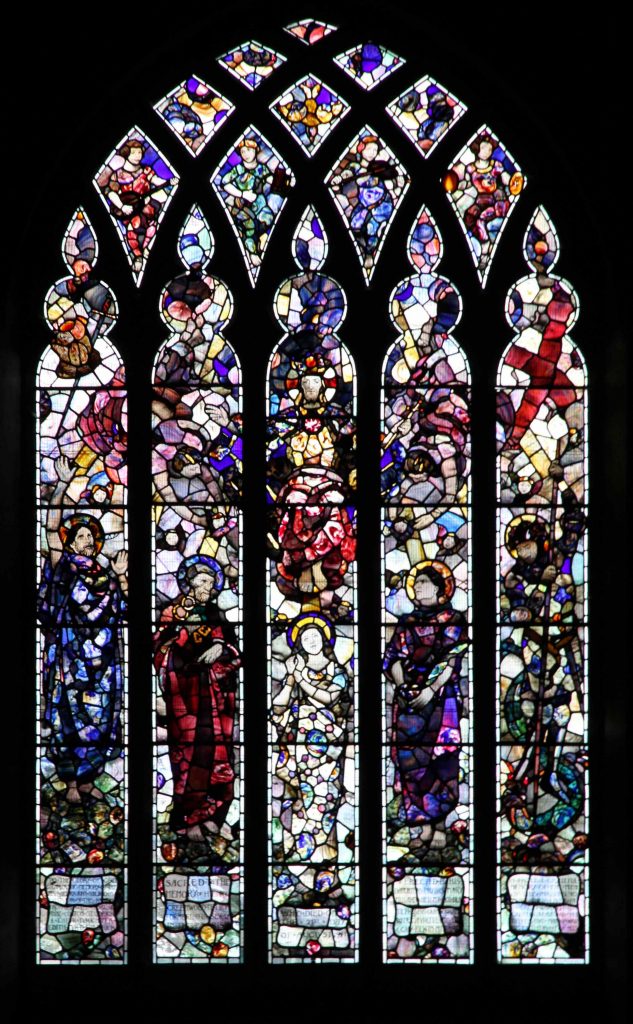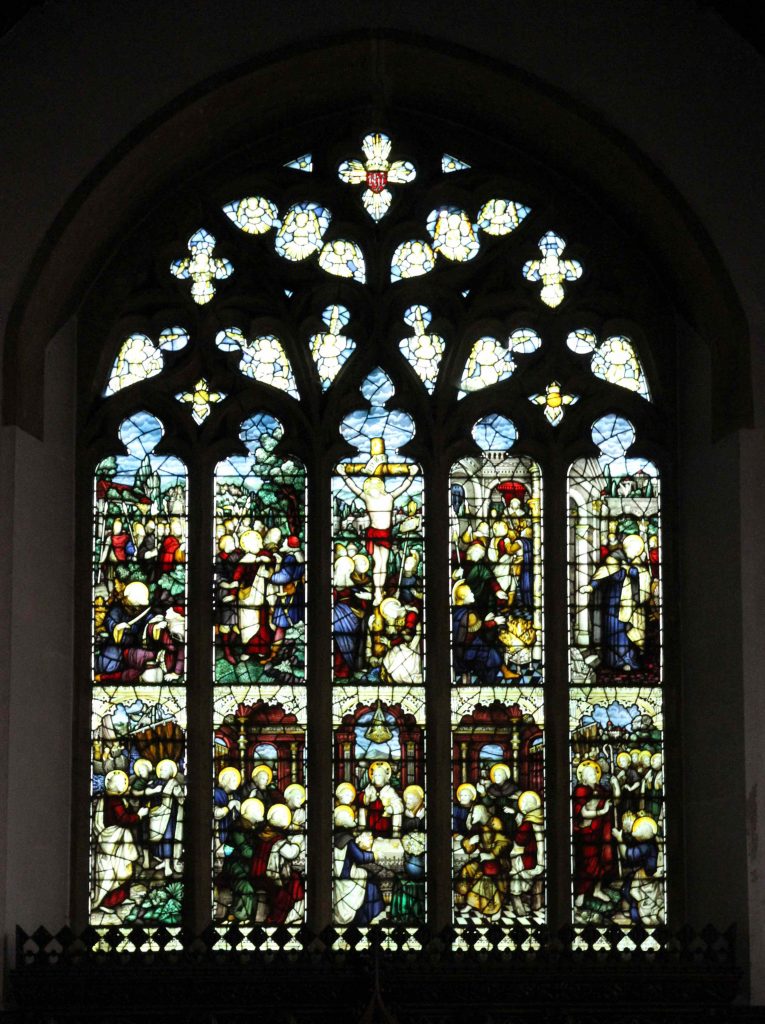The life and worship of St Peter’s Church
St Peters Bocking, sometimes known as St Peters in the fields, is the parish church for over 12,000 people in Braintree and Bocking. The church building is located near to Causeway House and the Public Gardens. Although unusual in appearance from the outside it has a number of fine features including stained glass windows by Walker and the Kemp school, a screen carved by Beckwith and a sculpture of St Peter by John Doubleday.

Why are we here?
We aim to be a Christian presence in the community, to offer worship and prayer that will help people find meaning and purpose in their lives, and to help serve the spiritual needs of those who come to us.
At the centre of our life is the celebration of Holy Communion where we recall the death and resurrection of Jesus, because we believe that it is through this weekly celebration of God’s grace and love that we are built up in our faith. Our style of worship uses the best of the Anglican tradition and we are very fortunate to have an excellent mixed choir that greatly enriches our worship. We feel strongly that a properly ordered and dignified setting for the worship of God helps to give us the deepest experience of God’s grace and love.
Our Sunday Services are at 8 am (Book of Common Prayer Holy Communion 1662), and at 10 am (Sung Communion). On the fourth Sunday in the month we have Evensong from the Book of Common Prayer at 6 pm. Our Sunday Club (for children aged 4 and over) meets in the Church Hall on 3rd Sundays during Term time, and joins the Service towards the end.
During the week there are said services to which all are invited – Tuesdays at 9.30 am and Fridays at 1 pm. These are quiet and reflective and give us the opportunity to bring the needs of the parish to God. There is an intercessions board at the front of the church where people are encouraged to place their prayer requests, and if they wish, to light a candle.
We also believe that it is important to provide a variety of worship that tries to meet the needs of adults and children and so on the first Sunday in the month we have a Family Communion which is shorter, more informal and involves the children.
We have monthly groups for Discussion (called A Question of Faith?), Bible study, and Poetry reading, and during Lent we meet together over 5 weeks to learn more about our faith through study, discussion and prayer.
Please see the Diary and This Week pages which highlight any special services and seasonal variations.
History and Architecture
The cost of building the Church was funded from a bequest from Miss Frances Wakeham who died on 14th March 1893. Miss Wakeham left £4,500 towards the building of a second Church in the Parish of Bocking. The design is by Victorian architect John Micklethwaite. Work began on 8th June 1896 and the nave, chancel and vestries being the completed first parts were consecrated by the Bishop of St. Alban’s (the Rt. Revd Dr. John Wogan Festing) on 18th June 1897.
Originally St. Peter’s was conceived as a single building to seat 300 people. However, it was felt that due to a possible increase in population, the Church needed the facility to be converted to seat 600. The early finances of the Church were such that the Church was often in debt and so no money could be raised to finance the building of a larger Church. To this day the Church has not been finished and just consists of the nave, chancel and vestries. The side aisles which were part of the original plan have never been completed.
The Church is built of yellow brick. The roof is surmounted by a belfry which was never finished. It has two bells which, silent for many years after being struck by lightning, have recently been rehung and are now in regular use. The visitor enters the Church by the south door and proceeds via a central aisle flanked each side with pews and five pointed arches. Above the small arches are five small windows (known as the clerestory windows). These windows are inscribed with the letters F and W (the initials of Miss Frances Wakeham).
The chancel contains a splendid oak screen carved by a local craftsman from Coggeshall. Behind the altar is the carved oak reredos. St. Peter’s is said to have some of the finest Edwardian carving in Essex. The organ pipes are situated above the vestry but face out into the Chancel. The organ console is just in front of the Screen. The choirstalls are situated in the chancel.
The roof is barrel vaulted with a number of interesting coloured bosses.
The most impressive architectural feature of the Church is the west window (see below). This is a fine example of twentieth century stained glass, by Leonard Walker. There are five lights (panels of glass) depicting St. Peter, St. Paul, St. John, St. Mary and St. George slaying the dragon. The central feature of the window is the risen Christ who is surrounded by angels. At the top of the window are various angels playing musical instruments and in the top centre of the window is a dove which represents the Holy Spirit
The east window, by Tower, is in the Kemp style – details below. The most recent addition to the Church is a bronze sculpture of St. Peter which is hung on the north wall. The bronze which is over five feet tall was a gift to the Church from a former vicar, to mark its centenary. The sculpture is by John Doubleday who lives in Maldon – please see photograph below.

The West Window of St. Peter’s, Bocking
This is by a very well known maker of stained glass – Leonard Walker – and was dedicated on 27th May 1926 by the then Bishop of Colchester and is in memory of the Revd H J Shildrick, the first Vicar of St Peter’s (1897 – 1926), and his wife and daughter;
and to the memory of the 26 men of the parish who died in the Great War;
and to the memory of the late H Tetley, formerly managing director of Courtauld’s.
It shows in its main panels: Christ Crowned in Glory, surrounded by angels;
and from left to right: St Paul, St Peter, the Blessed Virgin Mary, St John, and St George.
Underneath the window is the War Memorial naming those lost, and given by W F Crittall.
It is significant that 2 of the great Braintree and Bocking employers of past years are thus represented in our window and memorial!
At the time, Leonard Walker was renowned for his use of colour, and a revival of the more ancient effects created in coloured glass, which was considered by some to have been lost in the rather duller effect of more traditional, Victorian glass – as per our East Window – still nice, but maybe not so vibrant.

The West Window
The East Window
The East window is earlier, around 1911, and was probably made by a Mr Tower (his rebus, a wheat sheaf surmounted by a tower, can be seen at the bottom left hand corner of the window). However, the window has also been ascribed to Kempe and Co. (a more famous maker!….).
It shows scenes from the life of St Peter: (in order they are):
Bottom left: the call of St Peter by the Sea of Galilee;
Bottom 3 panels: the Last Supper.
Top left 2 panels: With Jesus in the garden of Gethsemane – Peter draws his sword;
Middle top panel – the crucifixion – Peter is absent;
Top right 2 panels: Peter in the courtyard of the High Priest’s house denies 3 times that he knows Jesus;
Bottom right panel: after the resurrection, Jesus, holding a shepherd’s crook, forgives Peter’s denials and re-instates him, commissioning him to “feed my lambs, feed my sheep”.

The East Window